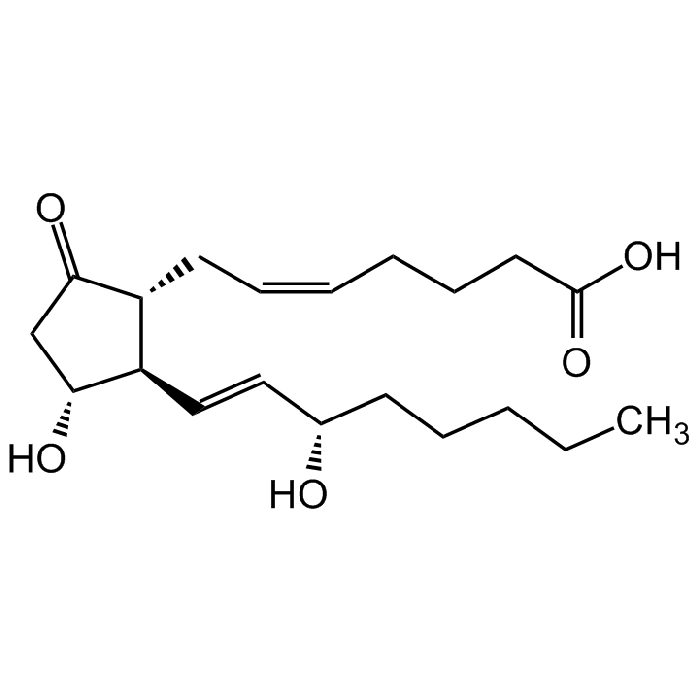Cookie Policy: This site uses cookies to improve your experience. You can find out more about our use of cookies in our Privacy Policy. By continuing to browse this site you agree to our use of cookies.
Chemodex
Prostaglandin E2

| Product Details | |
|---|---|
| Synonyms | Dinoprostone; ((5Z,11a,13E,15S)-11,15-Dihydroxy-9-oxoprosta-5,13-dienoic acid; PGE2 |
| Product Type | Chemical |
| Properties | |
| Formula |
C20H32O5 |
| MW | 352.47 |
| CAS | 363-24-6 |
| RTECS | UK8000000 |
| Source/Host Chemicals | Synthetic |
| Purity Chemicals | ≥98% (HPLC) |
| Appearance | White to light yellow solid. |
| Solubility | Soluble in ethanol (50 mg/ml), DMSO (50 mg/ml) or DMF (100 mg/ml). Sparingly soluble in PBS, pH 7.2 (5mg/ml). |
| Identity | Determined by 1H-NMR. |
| Declaration | Manufactured by Chemodex. |
| Other Product Data |
Click here for Original Manufacturer Product Datasheet |
| InChi Key | XEYBRNLFEZDVAW-ARSRFYASSA-N |
| Smiles | O=C1C[C@@H](O)[C@H](/C=C/[C@@H](O)CCCCC)[C@H]1C/C=C\CCCC(O)=O |
| Shipping and Handling | |
| Shipping | AMBIENT |
| Short Term Storage | +4°C |
| Long Term Storage | -20°C |
| Handling Advice | Protect from light and moisture. |
| Use/Stability | Stable for at least 2 years after receipt when stored at -20°C. |
| Documents | |
| Product Specification Sheet | |
| Datasheet |
 Download PDF Download PDF |
Prostaglandin E2 is one of the most typical lipid mediators produced from arachidonic acid (AA) by cyclooxygenase (COX) as the rate-limiting enzyme and acts on four kinds of receptor subtypes (EP1, EP2, EP3 and EP4) with high binding affinity. It is a regulator of numerous physiological functions ranging from reproduction to neuronal, metabolic and immune functions. It acts as a pro-inflammatory mediator, but also exerts anti-inflammatory responses. As pro-inflammatory mediator, PGE2 contributes to the regulation of the cytokine expression profile of DCs and has been reported to bias T cell differentiation towards a T helper (Th) 1 or Th2 response. It exerts anti-inflammatory actions on innate immune cells like neutrophils, monocytes and NK cells. Prostaglandin E2 also facilitates tumor progression through stimulation of angiogenesis via EP2, mediates cell invasion and metastasis formation via EP4 and promotes cell survival by inhibiting apoptosis via numerous signaling pathways. Recently it has been shown to inhibit NLRP3 by acting through receptor EP4 activation that increases cAMP. cAMP activates PKA that phosphorylates NLRP3 at serine 295. PKA phosphorylation of NLRP3 inhibits the NLRP3 ATPase activity, which is required for assembly of NLRP3-ASC complexes.
(1) D. F. Legler, et al.; Int. J. Biochem. Cell Biol. 42, 198 (2010) (Review) | (2) D. Sakata, et al.; J. Pharmacol. Sci. 112, 1 (2010) (Review) | (3) E.M. Durand, et al.; Curr. Opin. Hematol. 17, 308 (2010) (Review) | (4) J. Reader, et al.; Cancer Metastasis Rev. 30, 449 (2011) (Review) | (5) V. Sreeramkumar, et al.; Immunol. Cell Biol. 90, 579 (2012) (Review) | (6) P. Kalinski; J. Immunol. 188, 21 (2012) (Review) | (7) M. Rodriguez, et al.; Mol. Pharmacol. 85, 187 (2014) (Review) | (8) K. Kawahara, et al.; Biochim. Biophys Acta. 1851, 414 (2015) (Review) | (9) M. Sokolowska, et al.; J. Immunol. 194, 5472 (2015)





